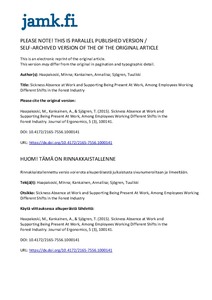Sickness Absence at Work and Supporting Being Present At Work, Among Employees Working Different Shifts in the Forest Industry
Haapakoski, Minna; Kankainen, Annaliisa; Sjögren, Tuulikki (2015)
Haapakoski, Minna
Kankainen, Annaliisa
Sjögren, Tuulikki
OMICS International
2015
Julkaisun pysyvä osoite on
https://urn.fi/URN:NBN:fi:amk-2018111317069
https://urn.fi/URN:NBN:fi:amk-2018111317069
Tiivistelmä
Objective: Shift work has negative effects on employee overall health, including sleep disorder, depressive symptoms, and cardiovascular and metabolic diseases. The association between shift work and the prevalence of sickness absence has been less studied. This study investigated sickness absence among employees working different work shift schedules in the forest industry.
Method: This descriptive cross-sectional study used employee (N=636) data from forest industry sick-leave registers. The study population (n=280; women n=90 and men=189) worked five different shifts. Each of the five shifts was analyzed separately for sickness absence rate and the results were compared using independent and paired samples t-test.
Results: Persons working a three-shift rotation five days week (TAM35) had a significantly higher sickness absence rate (P=0.001) than those working a two-shift rotation (TAM25). Among those working the three-shift rotation five days a week (TAM35) older male and female employees had more absences than their younger counterparts.
Conclusion: The three-shift model showed the highest association with sickness absence. This model does not support human physiological circadian rhythms. Of the five shift schedules studied, the day-shift (five days a week) and two-shift (five morning shifts and five evening shifts) models supported employee health.
Method: This descriptive cross-sectional study used employee (N=636) data from forest industry sick-leave registers. The study population (n=280; women n=90 and men=189) worked five different shifts. Each of the five shifts was analyzed separately for sickness absence rate and the results were compared using independent and paired samples t-test.
Results: Persons working a three-shift rotation five days week (TAM35) had a significantly higher sickness absence rate (P=0.001) than those working a two-shift rotation (TAM25). Among those working the three-shift rotation five days a week (TAM35) older male and female employees had more absences than their younger counterparts.
Conclusion: The three-shift model showed the highest association with sickness absence. This model does not support human physiological circadian rhythms. Of the five shift schedules studied, the day-shift (five days a week) and two-shift (five morning shifts and five evening shifts) models supported employee health.
